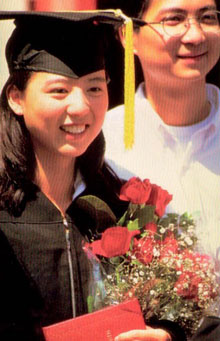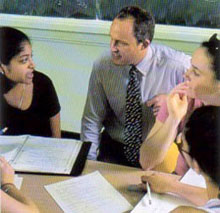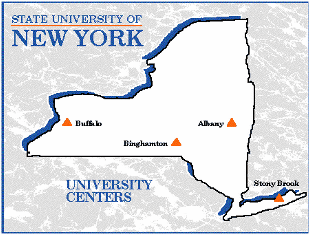|
● Going
to School in America Today
● Education—A Local Matter
● What
an American Student Learns
● Education
in a New Nation
● Learning
to Be World Citizens
● Higher Education
● Selecting
a College or University
● Trends in Degree Programs
● Education for All
Selecting a College or University
 |
|
A Girl College Student
|
 In
addition to learning about a school's entrance requirements (and
its fees), Americans have a lot of questions to think about when
they choose a university or college. They need to know: In
addition to learning about a school's entrance requirements (and
its fees), Americans have a lot of questions to think about when
they choose a university or college. They need to know:
 What
degrees does the school offer? How long does it take to earn one?
At the undergraduate (college) level, a four-year "liberal
arts" course of study is traditionally offered in such
subjects as history, languages and philosophy. (The term "liberal
arts" comes from "liberales artes", a Latin expression
for free, or human, arts and skills. In the time of the Roman Empire
these were skills and arts that only a free person—not a slave—could acquire.) Many liberal arts colleges also offer a bachelor
of science (B.S.) degree in physics, chemistry or other scientific
subjects. A technical training institution, offering such courses
as agriculture or business, offers courses of varying lengths, and
community college studies last two years. What
degrees does the school offer? How long does it take to earn one?
At the undergraduate (college) level, a four-year "liberal
arts" course of study is traditionally offered in such
subjects as history, languages and philosophy. (The term "liberal
arts" comes from "liberales artes", a Latin expression
for free, or human, arts and skills. In the time of the Roman Empire
these were skills and arts that only a free person—not a slave—could acquire.) Many liberal arts colleges also offer a bachelor
of science (B.S.) degree in physics, chemistry or other scientific
subjects. A technical training institution, offering such courses
as agriculture or business, offers courses of varying lengths, and
community college studies last two years.
 |
|
Group Discussion
|
 Graduate
schools in America award master's and doctor's degrees in both the
arts and sciences. (The term "doctor" comes from the Latin
word docere, meaning "to teach.") The courses for most
graduate degree can be completed in two to four years. But if a
graduate program requires original research, a student could spend
many additional months or even years in a university library or
laboratory. Graduate
schools in America award master's and doctor's degrees in both the
arts and sciences. (The term "doctor" comes from the Latin
word docere, meaning "to teach.") The courses for most
graduate degree can be completed in two to four years. But if a
graduate program requires original research, a student could spend
many additional months or even years in a university library or
laboratory.
 What
curricula does a college or university offer? What are the requirements
for earning a degree? In an American university, each college and
graduate school has its own curriculum.
At the undergraduate level, there may be some courses that every
student has to take (for example, classes in world history, math,
writing or research). But students do select their "major"
(the field in which they want their degree), plus a specific number
of "electives" (courses that are not required but that
students may choose). The National Institute of Education, a government
agency, reports that a total of more than 1 000 majors are offered
in America's colleges and universities. The combined electives available
in these schools probably amount to a number in the tens of thousands. What
curricula does a college or university offer? What are the requirements
for earning a degree? In an American university, each college and
graduate school has its own curriculum.
At the undergraduate level, there may be some courses that every
student has to take (for example, classes in world history, math,
writing or research). But students do select their "major"
(the field in which they want their degree), plus a specific number
of "electives" (courses that are not required but that
students may choose). The National Institute of Education, a government
agency, reports that a total of more than 1 000 majors are offered
in America's colleges and universities. The combined electives available
in these schools probably amount to a number in the tens of thousands.
 Typically,
an undergraduate
student has to earn a certain number of "credits"
(about 120) in order to receive a degree at the end of four years
of college. Credits are earned by attending lectures (or lab classes)
and by successfully completing assignments
and examinations. One credit usually equals one hour of class per
week in a single course. A three-credit courses in biology could
involve two hours of lectures plus one hour in a science lab, every
week. A course may last 10 to 16 weeks-the length of a "semester." Typically,
an undergraduate
student has to earn a certain number of "credits"
(about 120) in order to receive a degree at the end of four years
of college. Credits are earned by attending lectures (or lab classes)
and by successfully completing assignments
and examinations. One credit usually equals one hour of class per
week in a single course. A three-credit courses in biology could
involve two hours of lectures plus one hour in a science lab, every
week. A course may last 10 to 16 weeks-the length of a "semester."
 Is
the college or university a public institution (operated by a state
or local government) or a private one? If it is private, is it a
religious school? The United States does not have a national (federal)
school system, but each of the 50 states operates its own universities,
and so do some large city governments. (The government does grant
degrees in the schools it operates for professional members of the
armed services for example, the
United States Naval Academy at Annapolis, Maryland. Is
the college or university a public institution (operated by a state
or local government) or a private one? If it is private, is it a
religious school? The United States does not have a national (federal)
school system, but each of the 50 states operates its own universities,
and so do some large city governments. (The government does grant
degrees in the schools it operates for professional members of the
armed services for example, the
United States Naval Academy at Annapolis, Maryland.
 About
25 percent of all schools of higher education in the United States
are privately operated by religious organizations. Most are open
to students of different faiths,
but in some religious schools all students are required to attend
religious services. There are also privately owned schools with
no religious connection. About
25 percent of all schools of higher education in the United States
are privately operated by religious organizations. Most are open
to students of different faiths,
but in some religious schools all students are required to attend
religious services. There are also privately owned schools with
no religious connection.
 Both
public and private colleges depend on three sources of income: student
tuition,
endowments
(gifts made by wealthy benefactors)
and government funding. Some endowments are very large: Harvard,
Princeton and
Yale Both
public and private colleges depend on three sources of income: student
tuition,
endowments
(gifts made by wealthy benefactors)
and government funding. Some endowments are very large: Harvard,
Princeton and
Yale
 |
 |
|
Princeton University
|
Yale library
|
Universities have more than a thousand
million dollars each. Public institutions receive a large portion
of public tax money than private schools do.
 |
|
SUNY
|
 How
large is the school? There are many small American colleges—some
with fewer than 100 students. But the larger universities tend to
keep attracting larger numbers of enrollments. By the mid-1980s,
at least seven universities had total enrollments of over 100 000
each. (One of the seven, the State University of New York, had more
than 60 campuses in different parts of the state.) How
large is the school? There are many small American colleges—some
with fewer than 100 students. But the larger universities tend to
keep attracting larger numbers of enrollments. By the mid-1980s,
at least seven universities had total enrollments of over 100 000
each. (One of the seven, the State University of New York, had more
than 60 campuses in different parts of the state.)
 |
|
The Mainframe
|
 Why
do the large universities flourish?
Until recent years, a major answer to this question was: They offer
the best libraries and facilities for scientific research. Access
to a "mainframe"
(very large) computer and to modern laboratories attracts leading
scientists to the faculties of such schools. And students enroll
to study with the experts. Research programs continue to be important
to the reputation of America's universities. But in recent years,
the percentage of advanced degrees awarded in the "pure"
(research) sciences has declined17. The same has been true for the
liberal arts. Students continue to seek the largest, most respected
universities—but for new and different programs. Why
do the large universities flourish?
Until recent years, a major answer to this question was: They offer
the best libraries and facilities for scientific research. Access
to a "mainframe"
(very large) computer and to modern laboratories attracts leading
scientists to the faculties of such schools. And students enroll
to study with the experts. Research programs continue to be important
to the reputation of America's universities. But in recent years,
the percentage of advanced degrees awarded in the "pure"
(research) sciences has declined17. The same has been true for the
liberal arts. Students continue to seek the largest, most respected
universities—but for new and different programs.
Previous Page Next
Page
|

